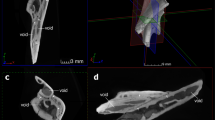Summary
A dorsal pterygoid element and a ventral ectopterygoid element can be recognised during the development of monotremes, marsupials and eutherian mammals. Their homology with the elements so named in fossils ancestral to mammals can be established by positional evidence. In monotremes the elements remain distinct and show specialised features, including a hamular cartilage in the ectopterygoid of one specimen of Ornithorhynchus. In most higher mammals the pterygoid element is much reduced and is replaced anteriorly by the perpendicular plate of the palatine. Posteriorly the pterygoid element fuses with the ectopterygoid, in many cases before the onset of ossification. The hamular cartilage arises by chondrification within the ectopterygoid element and shows no sign of being a separate morphological entity, but must be regarded as a specialised feature associated with the architecture of the palatal musculature. There is a strong case for the value of recognising that the ‘pterygoid process’ of higher mammals includes both a pterygoid and an ectopterygoid moiety.
Similar content being viewed by others
References
Alexander, R.McN.: The chordates. London: Cambridge University Press (1975)
Beer, G.R., de: The development of the skull of the shrew. Phil. Trans. Roy. Soc. B 217, 411–480 (1929)
Beer, G.R., de: The development of the vertebrate skull. Oxford University Press 1937
Beer, G.R., de, Fell, W.A.: The development of the skull of Ornithorhynchus. Trans. Zool. Soc. Lond. 23, 1–42 (1936)
Bemmelen, J.F., van: Der Schädelbau der Monotremen. Denkschr. med.-naturw. Ges. Jena 3, 729–798 (1901)
Broom, R.: On the origin of mammals. Phil. Trans. Roy. Soc. B 206, 1–48 (1914)
Carter, G.S.: Structure and habit in vertebrate evolution. London: Sidgwick and Jackson 1967
Edgeworth, F.H.: The development of the cranial muscles of Tatusia and Manis. J. Anat. 57, 313–335 (1923)
Fawcett, E.: The early stages of the ossification of the pterygoid plates of the human sphenoid. J. Anat. 39, vi–viiP (1905)
Fourie, S.: The cranial morphology of Thrinaxodon liorhinus Seely. Ann. S. Afr. Mus. 65, 367–400 (1974)
Frazer, J.E.: Manual of embryology. London: Bailliere, Tindall and Cox 1931.
Fuchs, H.: Ueber das Pterygoid, Palatinum und Parasphenoid der Quadrupeden. Anat. Anz. 36, 33–95 (1910)
Gaupp, E.: Zur Entwicklungsgeschichte und vergleichenden Morphologie des Schädels von Echidna aculeata var typica. Denkschr. med.-naturw. Ges. Jena 8, 539–788 (1908)
Goodrich, E.S.: Studies on the structure and development of vertebrates. London: Macmillan 1930
Gray, H.: Gray's Anatomy (Warwick, R., Williams, P.L. eds.) (35th edition). Edingurgh: Longman 1973
Green, H.L.H.H.: A description of the egg tooth of Ornithorhynchus, together with some notes on the development of the palatine processes of the premaxilla. J. Anat. 64, 512–522 (1930)
Jollie, M.: Chordate morphology. New York: Reinhold 1962
Kampen, P.N., van: Parasphenoid und Basisphenoid der Säugetiere. Bijdr. Dierk. 22, 53–58 (1922)
Kesteven, H.L.: ‘The homology of the mammalian alisphenoid and of the echidna pterygoid’ J. Anat. 52, 223–238 (1918)
Kuhn, H.J.: Die Entwicklung und Morphologie des Schädels von Tachyglossus aculeatus. Abh. senckenb. naturforsch. Ges. 528, 1–224 (1971)
Lubosch, W.: Das Kiefergelenk der Edentaten und Marsupialier. Denkschr. med.-naturw.Ges.Jena 7, 1–38 (1907)
MacIntyre, G.T.: Foramen pseudovale and quasi-mammals. Evolution, Lancaster, Pa. 21, 834–841 (1967)
Parker, W.K.: The structure and development of the skull in mammalia (Part II Edentata, Part III, Insectivora). Phil. Trans. Roy. Soc. B 176, 1–275 (1885)
Parrington, F.R., Westoll, T.S.: The Evolution of mammalian palate. Proc Roy. Soc. B 230, 305–355 (1940)
Peter, K.: Über graphische Rekonstruktion in Schrägansicht. Z. wiss. Mikrosk. 39, 138–148 (1922)
Reinbach, W.: Zur Entwicklung des Primordial-craniums von Dasypus novemcinctus Linné. (I) Z. Morph. Anthrop. 44, 375–444; (II) Z. Morph. Anthrop. 45, 1–72 (1952)
Roux, G.H.: The cranial development of certain ethiopian insectivores and its bearing on the mutual affinities of the group. Acta Zoologica, Stockh. 28, 165–397 (1947)
Schneider, R.: Zur Entwicklung des Chondrocraniums der Gattung Bradypus. Morph. Jb. 96, 209–307 (1955)
Stadtmüller, F.: Kranium und Visceral-Skelett der Säugetiere. In: Bolk, Goppert, Kallius, Lubosch: Hdb. der vgl. Anat. d. Wirbeltiere 4, 839–1016 (1936)
Starck, D.: Le crâne des mammifères, in Grasse: Traité de Zoologie XVI (1), 405–549. Paris: Masson (1967)
Watson, D.M.S.: The monotreme skull: A contribution to mammalian morphogenesis. Phil. Trans. Roy. Soc. B 207, 311–374 (1916)
Author information
Authors and Affiliations
Rights and permissions
About this article
Cite this article
Presley, R., Steel, F.L.D. The pterygoid and ectopterygoid in mammals. Anat. Embryol. 154, 95–110 (1978). https://doi.org/10.1007/BF00317957
Accepted:
Issue Date:
DOI: https://doi.org/10.1007/BF00317957




